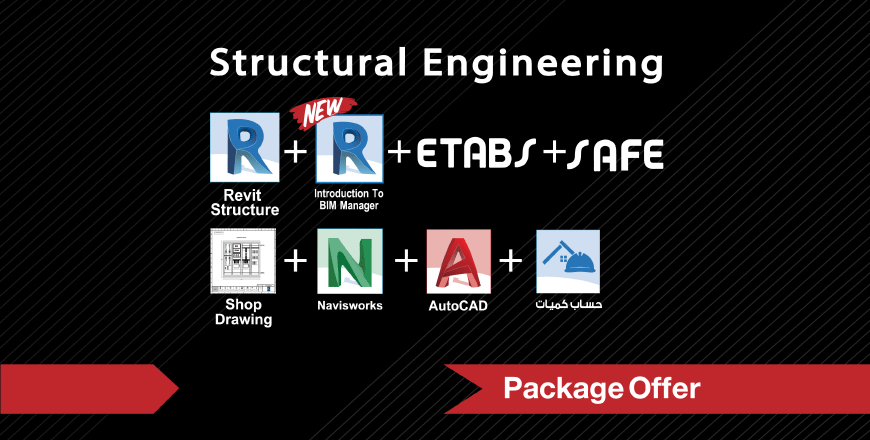Introduction to BIM
- What is BIM
- BIM dimensions
- BIM benefits
- Relationship between Revit and BIM
3d Modeling
- Modeling of vertical elements such as columns, and walls
- Modeling of horizontal elements such as slabs, beams, and foundations
- Modeling of other structural elements
- Sections and callouts in Revit
Cad Format Sheets to Revit Format
- Importing CAD format file into Revit models
- Management of CAD files and the difference between importing CAD and linking CAD
- Converting CAD sheets to 3d Revit models
Setting the Visibility of Views
- View range and visibility and graphics
- Create and manage view templates
2d Annotation and Drafting
- Dimensions in Revit
- Spot elevations, spot slopes, and spot coordinations
- Tag versus text
- Drafting views and details
Revit Sheets
- Creating sheets and title blocks
- Preparing sheets for different submissions
- Placing views and legends into Revit sheets
Revit Schedules
- Quantities schedules
- Material takeoff
- Sheet list
- Other types of schedules in Revit
Parameters
- ? What are Revit parameters
- Project parameters
- Shared parameters
- The difference between parameter types
3d Rebar
- Why to use 3d rebar
- General settings of 3d rebar
- Creating and modeling of 3d rebar using Revit
- Shop drawings using Revit
- Rebar schedules
Linking Revit Formats
- Benefits of linking Revit for different disciplines and its role in solving clashes between
disciplines - Management of Revit link
Positioning
- Positioning in Revit for different format types
Revit in network environment
- Creating central files
- What are local files
- Synchronizing Revit models
Warnings in Revit
- How to solve warnings in Revit
Introduction to Revit families
- What are Revit families
- Family parameters
دورة (ETABS) تبدأ من الصفر الى الاحترافية والتعمق بالتصميم الزلزالي وتعمق في النمذجة أيضا. سوف يتم استخدام أكثر من 10 ملفات اكسل لحسابات لا تتم في برنامج (ETABS) مثل التأكد من ازاحة المبنى الطابقية والكلية والنسبية للمبنى وغيرها كثير.
محاور دورة
1- التعريف بالبرامج الهندسية وبالأخص برنامج (ETABS) التعريف بأهمية البرنامج للمهندس الانشائي وامكانياته
3- نمذجة مبنى كامل (نذكر الاوامر الرئيسية ) يشمل مايلي:-
1- تعلم كيفية ادخال شبكة المحاور وعدد الطوابق وارتفاعاتها.
2- تعريف المواد الداخلة في التصميم.
3- تعريف العناصر الانشائية.
4- رسم العناصر الانشائية .
5- وضع الاحمال على العناصر الانشائية .
6- ادخال احمال (الزلزالية والرياح ).
7- ادخال تراكيب الاحمال .
8- التأكد من عدوم وجود اخطاء نمذجة .
9- عمل تحليل وتصميم للعناصر الانشائية .
10- معرفة اتسخراج قيم التحليل لكل عنصر انشائي.
11- مقارنة بعض قيم التحليل يدويا .
12- معرفة استخراج قيم التصميم للعناصر الانشائية وبالاخص ( التسليح الناتج عن العزوم – التسليح الناتج عن القص – التسليح الناتج عن الفتل ) وباقي قيم التسليح .
13- مقارنة بعض قيم التسليح بالحل اليدوي مع البرنامج بواسطة ملف اكسل .
14- معرفة بعض الاوامر المهمة لاتمام النمذجة الصحيحة .
4- ادخال احمال الرياح .
5- احمال الزلازل يشمل مايلي:-
• ادخال احمال الزلزالية حسب الكود.
• أدخال تراكيب الاحمال الزلزالية.
• التأكد من كفاية التحليل الزلزالي الستاتيكي للمبنى او ضرورة عمل (التحليل الزلزالي الديناميكي ) حسب مايلي :-
1. معايرة اللامركزية (من خلال نتائج البرنامج، والحسابات باستخدام ملف اكسل).
2. عدم الانتظام العمودي.
3. الانقطاع في المستوي.
4. الزاوية الداخلية.
5. الانقطاع في الديافرام.
6. تغيرات مفاجئة خارج المستوى.
7. الجمل الغير متوازية.
8. معرفة وجود الطابق اللين (SOFT STORY) (من خلال نتائج البرنامج والحسابات باستخدام ملف اكسل).
9. معرفة وجود الطابق الثقيل (WEIGHT IRREGULARY) (من خلال نتائج البرنامج والحسابات باستخدام ملف اكسل).
10. معرفة وجود الطابق الضعيف (WEAK STORY) (من خلال نتائج البرنامج والحسابات باستخدام ملف اكسل).
11. معرفة وجود عدم انتظام الفتل (TORSIONAL IRREGULARIT (من خلال نتائج البرنامج، والحسابات باستخدام ملف اكسل ).
• التحليل الديناميكي للمبنى
1. تعريف التحليل الديناميكي.
2. معايرة التحليل الديناميكي.
3. اعادة ادخال تراكيب التحميل.
4. معايرة الانتقالات والازاحات: –
1. معايرة الازاحة الطابقية (من خلال نتائج البرنامج والحسابات باستخدام ملف اكسل).
2. معايرة الازاحة الطابقية النسبية (من خلال نتائج البرنامج والحسابات باستخدام ملف اكسل).
3. معايرة الانتقال الكلي (من خلال نتائج البرنامج والحسابات باستخدام ملف اكسل).
4. معالجة الانتقالات والازاحات ان وجدت.
5. معايرة (Δ P-) (من خلال نتائج البرنامج والحسابات باستخدام ملف اكسل).
• تصميم جدران القص.
6- كيفية تعريف كل انواع العقدات .
7- كيفية ادخال الادراج العادية والحلزونية .
8- كيفية رسم البلاطات والجسور والجدران الدائرية .
9- كيفية ادخال قبة في حال وجود قبة مسجد مثلا.
10- اخراج مذكرة حسابية للمشروع .
11- كيفية نمذجة مداخل الكراجات ( RAMP ).
12- كيفية تصدير العقدات الى برنامج (SAFE ).
13- كيفية تصدير احمال القواعد الى برنامج (SAFE).
14- كيفية استيراد مشروع من ملف الاتوكاد بعد عمل طبقات لكافة العناصر الانشائية
- Appending and merging models.
- Walking through your model.
- Working with viewpoints.
- Reviewing a model.
- Manipulating and finding objects.
- Adding links to objects.
- Adding a timeline with the TimeLine.
- Creating clash tests.
- Creating material takeoffs




